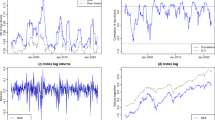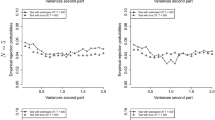Abstract
This paper examines the effects of permanent changes in the variance of the errors on routine applications of standard t-ratio test in regression models. It is shown the asymptotic distribution of t-ratio test is not invariant to non-stationary in variance, and the phenomenon of spurious regression will occur independently of the structure assumed for these time series. The intuition behind this is that the non-stationary volatility can increase persistency in the level of regression errors, which then leads to spurious correlation. Monte Carlo experiment evidence indicates that, in contrast to the broken level/trend case, the presence of spurious relationship critically depends on the location and magnitude of changes, regardless of the sample size. Finally, some real data sets from the Shanghai stock database are reported for illustration.

Similar content being viewed by others
References
Amado C, Teräsvirta T (2014) Modelling changes in the unconditional variance of long stock return series. J Empir Finance 22:15–35
Andrew DWK (1991) Heteroskedasticity and autocorrelation consistent covariance matrix estimation. Econometrica 59:817–858
Berkes I, Horva’th L, Kokoszka P, Shao Q (2005) Almost sure convergece of the bartlett estimator. Period Math Hung 51:11–25
Berkes I, Gombay E, Horváth L (2009) Testing for changes in the covariance structure of linear processes. J Stat Plan Inference 139:2044–2063
Billingsley P (1968) Convergence of probability measures. Wiley, New York
Busetti F, Taylor AMR (2003) Testing against stochastic trend in the presence of variance shifts. J Bus Econ Stat 48:225–234
Chatelain JB, Ralf K (2014) Spurious regressions and near-multicollinearity, with an application to aid, policies and growth. J Macroecon 29:85–96
Chen G, Choi YK, Zhou Y (2005) Nonparametric estimation of structural change points in volatility models for time series. J Econom 126:79–114
Choi C-Y, Hu L, Ogaki M (2008) Robust estimation for structural spurious regression and a Hausman-type cointegration tes. J Econ 142:327–351
Davidson J (1994) Stochastic limit theory. Oxford University Press, Oxford
de Jong R (2000) A strong consistency proof for heteroskedasticity and autocorrelation consistent covariance matrix estimators. Econometrica 64:813–836
Entorf H (1997) Random walks with drifts: nonsense regression and spurious fixed-effect estimation. J Econ 25:287–296
Granger CWJ, Newbold P (1974) Spurious regressions in econometrics. J Econ 2:111–120
Haldrup N (1994) The asymptotic of single-equation cointegratioin regressions with \(I(1)\) and \(I(2)\) variables. J Econ 63:153–181
Hamori S, Tokihisa A (1997) Testing for a unit root in the presence of a variance shift. Econ Lett 57:245–253
Hansen BE (1992a) Consistent covariance matrix estimation for dependent heterogeneous processes. Econometrica 60:967–972
Hansen BE (1992b) Convergence to stochastic integrals for dependent heterogeneous processes. Econ Theory 8:489–500
Hansen E, Rahbek A (1998) ARCH innovations and their impact on cointegration rank testing. Working Paper no. 22, University of Aarhus, Centre for Analytical Fianace
Horváth L, Kokoszka P (2003) A bootstrap approximation to a unit root test statistic for heavy-tailed observations. Stat Probab Lett 63:163–173
Inclán C, Tiao GC (1994) Use of cumulative sums of squares for retrospective detection of change of variance. J Am Stat Assoc 89:913–923
Jin H, Zhang J-S, Zhang S, Yu C (2013) The spurious regression of AR(p) infinite-variance sequence in the presence of structural breaks. Comput Stat Data Anal 67:25–40
Jin H, Zhang J (2011) Modified tests for variance changes in autoregressive regression. Math Comput Simul 81:1099–1199
Kim J-Y (2000) Detection of change in persistence of a linear time series. J Econ 95:97–116
Kim S, Cho S, Lee S (2000) On the cusum test for parameter changes in GARCH(1,1) models. Commun Stat Theroy Methods 29:445–462
Kim T-H, Leybourne S, Newbold P (2002) Unit root tests with a break in innovation variance. J Econ 109:365–387
Kim T-H, Lee Y-S, Newbold P (2004) Spurious regression with stationary processes around linear trends. Econ Lett 83:257–262
Kim K, Schmidt P (1993) Unit root tests with conditional heteroskedasticity. J Econ 59:287–300
Lamoreux CG, Lastrapes WD (1990) Persistence in variance, structural change and the GARCH model. J Bus Econ Stat 48:225–234
Lee S, Park S (2001) The cusum of squares test for scale changes in infinite order moving average processes. Scand J Stat 28:625–644
Marmol F (1998) Spurious regression theory with nonstationary fractionally integrated processes. J Econ 84:223–250
Neumann MH, Paparoditis E (2000) On bootstrapping \(L_2\)-type statistics in density testing. Stat Probab Lett 50:137–147
Noriega AE, Ventosa-Santaulària D (2007) Spurious regression and trending variables. Oxf Bull Econ Stat 69(I):439–444
Phillips PCB (1996) Understanding spurious regressions in econometrics. J Econ 33:311–340
Phillips PCB, Perron P (1988) Testing for a unit root in time series regression. Biometrika 75:335–346
Phillips PCB, Solo V (1992) Asymptotic for linear processes. Ann Stat 20:971–1001
Stewart C (2011) A note on spurious significance in regressions involving \(I(0)\) and \(I(1)\) variables. Econ Lett 142:327–351
Stout WF (1974) Almost sure convergence. Academic Press, New York
Sun Y (2004) Spurious regressions between stationary generalized long memory processes. Econ Lett 90:446–454
Tsay W-J, Chung C-F (2000) The spurious regression of fractionally integrated processes. J Econ 96:155–182
van Dijk D, Osborn DR, Sensier M (2002) Changes in variability of the business cycle in the G7 countries. Erasmus University Rotterdam, Rotterdam
Author information
Authors and Affiliations
Corresponding author
Additional information
Supported in part by a National Natural Science Foundation of China Grant Nos. 71103143, 71273206 and 71473194, Shaanxi Natural Science Foundation of China Grant Nos. 2013KJXX-40 and 16JK1500.
Appendix
Appendix
Proof of Lemma 1
Part (1) We consider two case: when \(r\le \tau \), by Assumption 1 and a functional central limit theorem as in Hansen (1992a), we have
and for the other case \(r>\tau \), the limit is
Therefore, we get
Similarly, it is straightforward to show that
Part (2) The convergence of \(T^{-1/2}\sum \nolimits ^{[Tr]}_{t=1}y_{1,t}\) and \(T^{-1}\sum \nolimits ^{T}_{t=1}y^2_{1,t}\) to \({\dot{\omega }}\sigma _\xi {\dot{B}}_{y}(r)\) and \({\dot{\omega }}^2\sigma ^2_\xi \) can be respectively proved by above exactly the same steps as in (1) case.
Part (3) We first deal with \(\tau \le \varsigma \). Note that \(\varepsilon _{1,t}\) and \(\xi _{1,t}\) are independent, when \(r\le \tau \), yielding
which follows the results in Stout (1974) and Davidson (1994).
Similarly, observing that for \(\tau <r\le \varsigma \),
and for \(\varsigma <r\),
Just as relations (7.3), (7.4) and (7.5) imply that
Hence, we conclude that
Thus following the proof of \(\tau \le \varsigma \), one can verify the negligibility of \(\tau >\varsigma \) case.
Part (4) For following convenience, let \(\sigma ^2_{1,x}=\sum ^{T-1}_{k=-T+1}h\left( k/q_T\right) \gamma _{1,x}(k)\), where for \(k\ge 0, \gamma _{1,x}(k)=T^{-1}\sum ^{T-k}_{t=1}E(x_{1,t}x_{1,t+k})\), while \(\gamma _{1,x}(k)=\gamma _{1,x}(-k)\) for \(k<0\), it suffices to prove that \(\sigma ^2_{1,x}-{\dot{\lambda }}^2\sigma ^2_\varepsilon \rightarrow 0\) as \(T\rightarrow \infty \).
Under the Assumptions 1 and 2, de Jong (2000) and Andrew (1991) guaranteed that \(\sigma ^2_{\varepsilon ,T}\rightarrow \sigma ^2_{\varepsilon }\), where \(\sigma ^2_{\varepsilon ,T}=\sum ^{T-1}_{k=-T+1}h\left( k/q_T\right) \gamma _{\varepsilon }(k), \gamma _{\varepsilon }(k)=E(\varepsilon _t\varepsilon _{t+|k|})\). Thus, we only just need to prove \(\sigma ^2_{1,x}-{\dot{\lambda }}^2\sigma ^2_{\varepsilon ,T}\rightarrow 0\). The remaider of the proof is necessary to show that, as \(T\rightarrow \infty \), (i) \(\sigma ^2_{1,x}-{\tilde{\sigma }}^2_{1,x}\rightarrow 0\), where \({\tilde{\sigma }}^2_{1,x}=\sum ^{T-1}_{k=-T+1}h\left( k/q_T\right) \gamma _{\varepsilon }(k)T^{-1}\sum ^{T-|k|}_{t=1}\lambda ^2_t\); (ii) \({\tilde{\sigma }}^2_{1,x}-{\dot{\lambda }}^2\sigma ^2_{\varepsilon ,T}\rightarrow 0\).
We first verify the (i) case. Observe that
By the theorem 3.1 of Phillips and Perron (1988) and corollary 14.3 of Davidson (1994), we obtain that for some \(C>0, \sum ^\infty _{k=0}|\gamma _\varepsilon (k)|<C\sum ^\infty _{k=0}\varphi ^{1-d/2}_{\varepsilon ,k}<\infty \), thus \(II<\infty \).
Let us now consider that \(I=o_p(1)\). Define \(\breve{\lambda }=\max \{\lambda _0,\lambda _1\}\), as \(T\rightarrow \infty \), we have
and therefore,
since \(\sup _{T\ge 1}q^{-2}_T\sum ^{T-1}_{k=-T+1}|h(k/q_T)||k|<\infty \) and \(q^2_T/T=o_p(1)\) under Assumption 2. Because \(I\rightarrow 0\) and II is bounded, this implies \(\sigma ^2_{1,x}-{\tilde{\sigma }}^2_{1,x}\rightarrow 0\).
Regarding (ii), by setting \({\tilde{\lambda }}^{2}=T^{-1}\sum ^T_{t=1}\lambda ^2_t\), after some algebra it follows that
It is straightforward to see that,
We conclude by showing that the foregoing results continue to hold and obtain \({\tilde{\sigma }}^2_{1,x}-{\tilde{\lambda }}^{2}\sigma ^2_{\varepsilon ,T}\rightarrow 0\). Moreover, under the Assumptions 1, \({\tilde{\lambda }}^{2}\sigma ^2_{\varepsilon ,T}-{\dot{\lambda }}^{2}\sigma ^2_{\varepsilon ,T}\rightarrow 0\) follows because the limit of \({\tilde{\lambda }}^{2}\) is \({\dot{\lambda }}^2\). Therefore, the limit of (7.6) and (7.7) tend to zero and the proof is completed. \(\square \)
Proof of Lemma 2
The proof follows trivially from Lemma 1 and is omitted for brevity. \(\square \)
Proof of Theorem 1
By Lemmas 1 and 2, it guarantees that
From the weak convergence \(\sum ^T_{t=1}x_{1,t}=O_p(T^{1/2})\) and \(\sum ^T_{t=1}y_{1,t}=O_p(T^{1/2})\), it implied that \(\hat{\eta }_t=(y_{1,t}-T^{-1}\sum ^T_{i=1}y_{1,i})-\hat{\beta }(x_{1,t}-T^{-1}\sum ^T_{i=1}x_{1,i}) =y_{1,t}-\hat{\beta }x_{1,t}+o_p(1)\). Thus, we have
which follows \(T^{-1}\sum ^T_{t=1}x_{1,t}y_{1,t+|k|}=o_p(1)\) and \(T^{-1}\sum ^T_{t=1}x_{1,t+|k|}y_{1,t}=o_p(1)\) as \(x_{1,s}\) and \(y_{1,t}\) are supposed to be independent for all \(s,t\ge 1\).
Together with (2.7) and (7.9), yields that
Using the Lemma 1 and fact \(\hat{\beta }\) is of \(O_p(T^{-1/2})\), we obtain
Combining these results with the asymptotic behavior of \(\hat{\beta }\), we get
Finally, we also have
Hence, the proof of Theorem 1 is completed.
Proof of Theorem 2
The idea of the proof is similar to Theorem 1 but, instead of Lemma 1, Lemma 2 is needed. \(\square \)
Rights and permissions
About this article
Cite this article
Jin, H., Zhang, S. & Zhang, J. Spurious regression due to neglected of non-stationary volatility. Comput Stat 32, 1065–1081 (2017). https://doi.org/10.1007/s00180-016-0687-x
Received:
Accepted:
Published:
Issue Date:
DOI: https://doi.org/10.1007/s00180-016-0687-x




